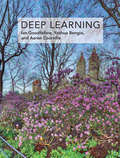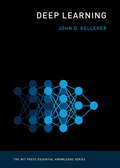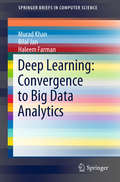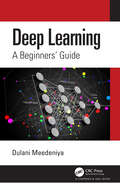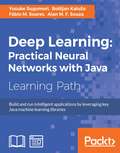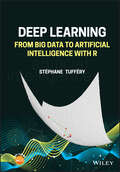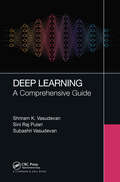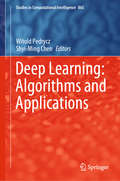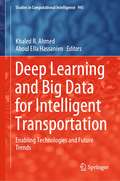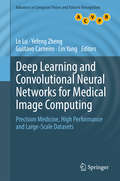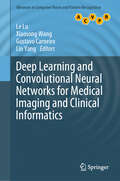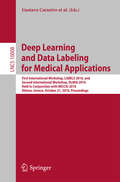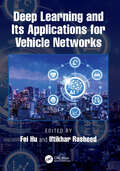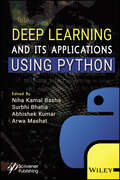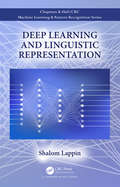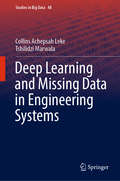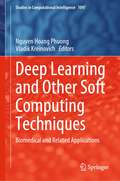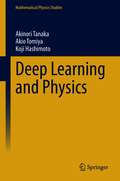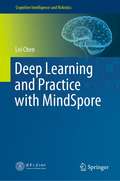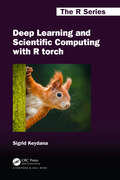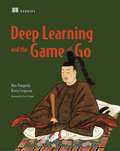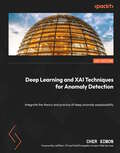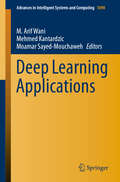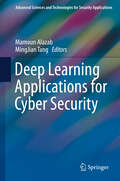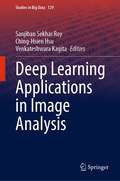- Table View
- List View
Deep Learning (Adaptive Computation and Machine Learning series)
by Ian Goodfellow Yoshua Bengio Aaron CourvilleAn introduction to a broad range of topics in deep learning, covering mathematical and conceptual background, deep learning techniques used in industry, and research perspectives.“Written by three experts in the field, Deep Learning is the only comprehensive book on the subject.”—Elon Musk, cochair of OpenAI; cofounder and CEO of Tesla and SpaceXDeep learning is a form of machine learning that enables computers to learn from experience and understand the world in terms of a hierarchy of concepts. Because the computer gathers knowledge from experience, there is no need for a human computer operator to formally specify all the knowledge that the computer needs. The hierarchy of concepts allows the computer to learn complicated concepts by building them out of simpler ones; a graph of these hierarchies would be many layers deep. This book introduces a broad range of topics in deep learning. The text offers mathematical and conceptual background, covering relevant concepts in linear algebra, probability theory and information theory, numerical computation, and machine learning. It describes deep learning techniques used by practitioners in industry, including deep feedforward networks, regularization, optimization algorithms, convolutional networks, sequence modeling, and practical methodology; and it surveys such applications as natural language processing, speech recognition, computer vision, online recommendation systems, bioinformatics, and videogames. Finally, the book offers research perspectives, covering such theoretical topics as linear factor models, autoencoders, representation learning, structured probabilistic models, Monte Carlo methods, the partition function, approximate inference, and deep generative models. Deep Learning can be used by undergraduate or graduate students planning careers in either industry or research, and by software engineers who want to begin using deep learning in their products or platforms. A website offers supplementary material for both readers and instructors.
Deep Learning (The MIT Press Essential Knowledge series)
by John D. KelleherAn accessible introduction to the artificial intelligence technology that enables computer vision, speech recognition, machine translation, and driverless cars.Deep learning is an artificial intelligence technology that enables computer vision, speech recognition in mobile phones, machine translation, AI games, driverless cars, and other applications. When we use consumer products from Google, Microsoft, Facebook, Apple, or Baidu, we are often interacting with a deep learning system. In this volume in the MIT Press Essential Knowledge series, computer scientist John Kelleher offers an accessible and concise but comprehensive introduction to the fundamental technology at the heart of the artificial intelligence revolution.Kelleher explains that deep learning enables data-driven decisions by identifying and extracting patterns from large datasets; its ability to learn from complex data makes deep learning ideally suited to take advantage of the rapid growth in big data and computational power. Kelleher also explains some of the basic concepts in deep learning, presents a history of advances in the field, and discusses the current state of the art. He describes the most important deep learning architectures, including autoencoders, recurrent neural networks, and long short-term networks, as well as such recent developments as Generative Adversarial Networks and capsule networks. He also provides a comprehensive (and comprehensible) introduction to the two fundamental algorithms in deep learning: gradient descent and backpropagation. Finally, Kelleher considers the future of deep learning—major trends, possible developments, and significant challenges.
Deep Learning: Convergence to Big Data Analytics (SpringerBriefs in Computer Science)
by Murad Khan Bilal Jan Haleem FarmanThis book presents deep learning techniques, concepts, and algorithms to classify and analyze big data. Further, it offers an introductory level understanding of the new programming languages and tools used to analyze big data in real-time, such as Hadoop, SPARK, and GRAPHX. Big data analytics using traditional techniques face various challenges, such as fast, accurate and efficient processing of big data in real-time. In addition, the Internet of Things is progressively increasing in various fields, like smart cities, smart homes, and e-health. As the enormous number of connected devices generate huge amounts of data every day, we need sophisticated algorithms to deal, organize, and classify this data in less processing time and space. Similarly, existing techniques and algorithms for deep learning in big data field have several advantages thanks to the two main branches of the deep learning, i.e. convolution and deep belief networks. This book offers insights into these techniques and applications based on these two types of deep learning.
Deep Learning: A Beginners' Guide
by Dulani MeedeniyaThis book focuses on deep learning (DL), which is an important aspect of data science, that includes predictive modeling. DL applications are widely used in domains such as finance, transport, healthcare, automanufacturing, and advertising. The design of the DL models based on artificial neural networks is influenced by the structure and operation of the brain. This book presents a comprehensive resource for those who seek a solid grasp of the techniques in DL. Key features: • Provides knowledge on theory and design of state-of-the-art deep learning models for real-world applications. • Explains the concepts and terminology in problem-solving with deep learning. • Explores the theoretical basis for major algorithms and approaches in deep learning. • Discusses the enhancement techniques of deep learning models. • Identifies the performance evaluation techniques for deep learning models. Accordingly, the book covers the entire process flow of deep learning by providing awareness of each of the widely used models. This book can be used as a beginners’ guide where the user can understand the associated concepts and techniques. This book will be a useful resource for undergraduate and postgraduate students, engineers, and researchers, who are starting to learn the subject of deep learning.
Deep Learning: Practical Neural Networks with Java
by Alan M. Souza Bostjan Kaluza Fabio M. Soares Yusuke SugomoriBuild and run intelligent applications by leveraging key Java machine learning libraries About This Book • Develop a sound strategy to solve predictive modelling problems using the most popular machine learning Java libraries. • Explore a broad variety of data processing, machine learning, and natural language processing through diagrams, source code, and real-world applications • This step-by-step guide will help you solve real-world problems and links neural network theory to their application Who This Book Is For This course is intended for data scientists and Java developers who want to dive into the exciting world of deep learning. It will get you up and running quickly and provide you with the skills you need to successfully create, customize, and deploy machine learning applications in real life. What You Will Learn • Get a practical deep dive into machine learning and deep learning algorithms • Explore neural networks using some of the most popular Deep Learning frameworks • Dive into Deep Belief Nets and Stacked Denoising Autoencoders algorithms • Apply machine learning to fraud, anomaly, and outlier detection • Experiment with deep learning concepts, algorithms, and the toolbox for deep learning • Select and split data sets into training, test, and validation, and explore validation strategies • Apply the code generated in practical examples, including weather forecasting and pattern recognition In Detail Machine learning applications are everywhere, from self-driving cars, spam detection, document search, and trading strategies, to speech recognitionStarting with an introduction to basic machine learning algorithms, this course takes you further into this vital world of stunning predictive insights and remarkable machine intelligence. This course helps you solve challenging problems in image processing, speech recognition, language modeling. You will discover how to detect anomalies and fraud, and ways to perform activity recognition, image recognition, and text. You will also work with examples such as weather forecasting, disease diagnosis, customer profiling, generalization, extreme machine learning and more. By the end of this course, you will have all the knowledge you need to perform deep learning on your system with varying complexity levels, to apply them to your daily work. The course provides you with highly practical content explaining deep learning with Java, from the following Packt books: 1. Java Deep Learning Essentials 2. Machine Learning in Java 3. Neural Network Programming with Java, Second Edition Style and approach This course aims to create a smooth learning path that will teach you how to effectively use deep learning with Java with other de facto components to get the most out of it. Through this comprehensive course, you'll learn the basics of predictive modelling and progress to solve real-world problems and links neural network theory to their application
Deep Learning: From Big Data to Artificial Intelligence with R
by Stephane TufferyDEEP LEARNING A concise and practical exploration of key topics and applications in data science In Deep Learning: From Big Data to Artificial Intelligence with R, expert researcher Dr. Stéphane Tufféry delivers an insightful discussion of the applications of deep learning and big data that focuses on practical instructions on various software tools and deep learning methods relying on three major libraries: MXNet, PyTorch, and Keras-TensorFlow. In the book, numerous, up-to-date examples are combined with key topics relevant to modern data scientists, including processing optimization, neural network applications, natural language processing, and image recognition. This is a thoroughly revised and updated edition of a book originally released in French, with new examples and methods included throughout. Classroom-tested and intuitively organized, Deep Learning: From Big Data to Artificial Intelligence with R offers complimentary access to a companion website that provides R and Python source code for the examples offered in the book. Readers will also find: A thorough introduction to practical deep learning techniques with explanations and examples for various programming libraries Comprehensive explorations of a variety of applications for deep learning, including image recognition and natural language processing Discussions of the theory of deep learning, neural networks, and artificial intelligence linked to concrete techniques and strategies commonly used to solve real-world problems Perfect for graduate students studying data science, big data, deep learning, and artificial intelligence, Deep Learning: From Big Data to Artificial Intelligence with R will also earn a place in the libraries of data science researchers and practicing data scientists.
Deep Learning: A Comprehensive Guide
by Shriram K Vasudevan Sini Raj Pulari Subashri VasudevanDeep Learning: A Comprehensive Guide provides comprehensive coverage of Deep Learning (DL) and Machine Learning (ML) concepts. DL and ML are the most sought-after domains, requiring a deep understanding – and this book gives no less than that. This book enables the reader to build innovative and useful applications based on ML and DL. Starting with the basics of neural networks, and continuing through the architecture of various types of CNNs, RNNs, LSTM, and more till the end of the book, each and every topic is given the utmost care and shaped professionally and comprehensively. Key Features Includes the smooth transition from ML concepts to DL concepts Line-by-line explanations have been provided for all the coding-based examples Includes a lot of real-time examples and interview questions that will prepare the reader to take up a job in ML/DL right away Even a person with a non-computer-science background can benefit from this book by following the theory, examples, case studies, and code snippets Every chapter starts with the objective and ends with a set of quiz questions to test the reader’s understanding Includes references to the related YouTube videos that provide additional guidance AI is a domain for everyone. This book is targeted toward everyone irrespective of their field of specialization. Graduates and researchers in deep learning will find this book useful.
Deep Learning: Algorithms and Applications (Studies in Computational Intelligence #865)
by Witold Pedrycz Shyi-Ming ChenThis book presents a wealth of deep-learning algorithms and demonstrates their design process. It also highlights the need for a prudent alignment with the essential characteristics of the nature of learning encountered in the practical problems being tackled. Intended for readers interested in acquiring practical knowledge of analysis, design, and deployment of deep learning solutions to real-world problems, it covers a wide range of the paradigm’s algorithms and their applications in diverse areas including imaging, seismic tomography, smart grids, surveillance and security, and health care, among others. Featuring systematic and comprehensive discussions on the development processes, their evaluation, and relevance, the book offers insights into fundamental design strategies for algorithms of deep learning.
Deep Learning and Big Data for Intelligent Transportation: Enabling Technologies and Future Trends (Studies in Computational Intelligence #945)
by Khaled R. Ahmed Aboul Ella HassanienThis book contributes to the progress towards intelligent transportation. It emphasizes new data management and machine learning approaches such as big data, deep learning and reinforcement learning. Deep learning and big data are very energetic and vital research topics of today’s technology. Road sensors, UAVs, GPS, CCTV and incident reports are sources of massive amount of data which are crucial to make serious traffic decisions. Herewith this substantial volume and velocity of data, it is challenging to build reliable prediction models based on machine learning methods and traditional relational database. Therefore, this book includes recent research works on big data, deep convolution networks and IoT-based smart solutions to limit the vehicle’s speed in a particular region, to support autonomous safe driving and to detect animals on roads for mitigating animal-vehicle accidents. This book serves broad readers including researchers, academicians, students and working professional in vehicles manufacturing, health and transportation departments and networking companies.
Deep Learning and Convolutional Neural Networks for Medical Image Computing
by Le Lu Yefeng Zheng Gustavo Carneiro Lin YangThis book presents a detailed review of the state of the art in deep learning approaches for semantic object detection and segmentation in medical image computing, and large-scale radiology database mining. A particular focus is placed on the application of convolutional neural networks, with the theory supported by practical examples. Features: highlights how the use of deep neural networks can address new questions and protocols, as well as improve upon existing challenges in medical image computing; discusses the insightful research experience of Dr. Ronald M. Summers; presents a comprehensive review of the latest research and literature; describes a range of different methods that make use of deep learning for object or landmark detection tasks in 2D and 3D medical imaging; examines a varied selection of techniques for semantic segmentation using deep learning principles in medical imaging; introduces a novel approach to interleaved text and image deep mining on a large-scale radiology image database.
Deep Learning and Convolutional Neural Networks for Medical Imaging and Clinical Informatics (Advances in Computer Vision and Pattern Recognition)
by Le Lu Xiaosong Wang Gustavo Carneiro Lin YangThis book reviews the state of the art in deep learning approaches to high-performance robust disease detection, robust and accurate organ segmentation in medical image computing (radiological and pathological imaging modalities), and the construction and mining of large-scale radiology databases. It particularly focuses on the application of convolutional neural networks, and on recurrent neural networks like LSTM, using numerous practical examples to complement the theory. The book’s chief features are as follows: It highlights how deep neural networks can be used to address new questions and protocols, and to tackle current challenges in medical image computing; presents a comprehensive review of the latest research and literature; and describes a range of different methods that employ deep learning for object or landmark detection tasks in 2D and 3D medical imaging. In addition, the book examines a broad selection of techniques for semantic segmentation using deep learning principles in medical imaging; introduces a novel approach to text and image deep embedding for a large-scale chest x-ray image database; and discusses how deep learning relational graphs can be used to organize a sizable collection of radiology findings from real clinical practice, allowing semantic similarity-based retrieval.The intended reader of this edited book is a professional engineer, scientist or a graduate student who is able to comprehend general concepts of image processing, computer vision and medical image analysis. They can apply computer science and mathematical principles into problem solving practices. It may be necessary to have a certain level of familiarity with a number of more advanced subjects: image formation and enhancement, image understanding, visual recognition in medical applications, statistical learning, deep neural networks, structured prediction and image segmentation.
Deep Learning and Data Labeling for Medical Applications
by Gustavo Carneiro Diana Mateus Loïc Peter Andrew Bradley João Manuel R. S. Tavares Vasileios Belagiannis João Paulo Papa Jacinto C. Nascimento Marco Loog Zhi Lu Jaime S. Cardoso Julien CornebiseThis book constitutes the refereed proceedings of two workshops held at the 19th International Conference on Medical Image Computing and Computer-Assisted Intervention, MICCAI 2016, in Athens, Greece, in October 2016: the First Workshop on Large-Scale Annotation of Biomedical Data and Expert Label Synthesis, LABELS 2016, and the Second International Workshop on Deep Learning in Medical Image Analysis, DLMIA 2016. The 28 revised regular papers presented in this book were carefully reviewed and selected from a total of 52 submissions. The 7 papers selected for LABELS deal with topics from the following fields: crowd-sourcing methods; active learning; transfer learning; semi-supervised learning; and modeling of label uncertainty. The 21 papers selected for DLMIA span a wide range of topics such as image description; medical imaging-based diagnosis; medical signal-based diagnosis; medical image reconstruction and model selection using deep learning techniques; meta-heuristic techniques for fine-tuning parameter in deep learning-based architectures; and applications based on deep learning techniques.
Deep Learning and Its Applications for Vehicle Networks
by Fei Hu Iftikhar RasheedDeep Learning (DL) is an effective approach for AI-based vehicular networks and can deliver a powerful set of tools for such vehicular network dynamics. In various domains of vehicular networks, DL can be used for learning-based channel estimation, traffic flow prediction, vehicle trajectory prediction, location-prediction-based scheduling and routing, intelligent network congestion control mechanism, smart load balancing and vertical handoff control, intelligent network security strategies, virtual smart and efficient resource allocation and intelligent distributed resource allocation methods. This book is based on the work from world-famous experts on the application of DL for vehicle networks. It consists of the following five parts: (I) DL for vehicle safety and security: This part covers the use of DL algorithms for vehicle safety or security. (II) DL for effective vehicle communications: Vehicle networks consist of vehicle-to-vehicle and vehicle-to-roadside communications. This part covers how Intelligent vehicle networks require a flexible selection of the best path across all vehicles, adaptive sending rate control based on bandwidth availability and timely data downloads from a roadside base-station. (III) DL for vehicle control: The myriad operations that require intelligent control for each individual vehicle are discussed in this part. This also includes emission control, which is based on the road traffic situation, the charging pile load is predicted through DL andvehicle speed adjustments based on the camera-captured image analysis. (IV) DL for information management: This part covers some intelligent information collection and understanding. We can use DL for energy-saving vehicle trajectory control based on the road traffic situation and given destination information; we can also natural language processing based on DL algorithm for automatic internet of things (IoT) search during driving. (V) Other applications. This part introduces the use of DL models for other vehicle controls. Autonomous vehicles are becoming more and more popular in society. The DL and its variants will play greater roles in cognitive vehicle communications and control. Other machine learning models such as deep reinforcement learning will also facilitate intelligent vehicle behavior understanding and adjustment. This book will become a valuable reference to your understanding of this critical field.
Deep Learning and its Applications using Python
by Niha Kamal Basha Surbhi Bhatia Khan Abhishek KumarArwa MashatThis book thoroughly explains deep learning models and how to use Python programming to implement them in applications such as NLP, face detection, face recognition, face analysis, and virtual assistance (chatbot, machine translation, etc.). It provides hands-on guidance in using Python for implementing deep learning application models. It also identifies future research directions for deep learning.
Deep Learning and Linguistic Representation (Chapman And Hall/crc Machine Learning And Pattern Recognition Ser.)
by Shalom LappinThe application of deep learning methods to problems in natural language processing has generated significant progress across a wide range of natural language processing tasks. For some of these applications, deep learning models now approach or surpass human performance. While the success of this approach has transformed the engineering methods of machine learning in artificial intelligence, the significance of these achievements for the modelling of human learning and representation remains unclear. Deep Learning and Linguistic Representation looks at the application of a variety of deep learning systems to several cognitively interesting NLP tasks. It also considers the extent to which this work illuminates our understanding of the way in which humans acquire and represent linguistic knowledge. Key Features: combines an introduction to deep learning in AI and NLP with current research on Deep Neural Networks in computational linguistics. is self-contained and suitable for teaching in computer science, AI, and cognitive science courses; it does not assume extensive technical training in these areas. provides a compact guide to work on state of the art systems that are producing a revolution across a range of difficult natural language tasks.
Deep Learning and Missing Data in Engineering Systems: Applications To Engineering Systems (Studies in Big Data #48)
by Collins Achepsah Leke Tshilidzi MarwalaDeep Learning and Missing Data in Engineering Systems uses deep learning and swarm intelligence methods to cover missing data estimation in engineering systems. The missing data estimation processes proposed in the book can be applied in image recognition and reconstruction. To facilitate the imputation of missing data, several artificial intelligence approaches are presented, including:deep autoencoder neural networks;deep denoising autoencoder networks;the bat algorithm;the cuckoo search algorithm; andthe firefly algorithm. The hybrid models proposed are used to estimate the missing data in high-dimensional data settings more accurately. Swarm intelligence algorithms are applied to address critical questions such as model selection and model parameter estimation. The authors address feature extraction for the purpose of reconstructing the input data from reduced dimensions by the use of deep autoencoder neural networks. They illustrate new models diagrammatically, report their findings in tables, so as to put their methods on a sound statistical basis. The methods proposed speed up the process of data estimation while preserving known features of the data matrix. This book is a valuable source of information for researchers and practitioners in data science. Advanced undergraduate and postgraduate students studying topics in computational intelligence and big data, can also use the book as a reference for identifying and introducing new research thrusts in missing data estimation.
Deep Learning and Other Soft Computing Techniques: Biomedical and Related Applications (Studies in Computational Intelligence #1097)
by Nguyen Hoang Phuong Vladik KreinovichThis book focuses on the use of artificial intelligence (AI) and computational intelligence (CI) in medical and related applications. Applications include all aspects of medicine: from diagnostics (including analysis of medical images and medical data) to therapeutics (including drug design and radiotherapy) to epidemic- and pandemic-related public health policies.Corresponding techniques include machine learning (especially deep learning), techniques for processing expert knowledge (e.g., fuzzy techniques), and advanced techniques of applied mathematics (such as innovative probabilistic and graph-based techniques).The book also shows that these techniques can be used in many other applications areas, such as finance, transportation, physics. This book helps practitioners and researchers to learn more about AI and CI methods and their biomedical (and related) applications—and to further develop this important research direction.
Deep Learning and Physics (Mathematical Physics Studies)
by Akinori Tanaka Akio Tomiya Koji HashimotoWhat is deep learning for those who study physics? Is it completely different from physics? Or is it similar? In recent years, machine learning, including deep learning, has begun to be used in various physics studies. Why is that? Is knowing physics useful in machine learning? Conversely, is knowing machine learning useful in physics? This book is devoted to answers of these questions. Starting with basic ideas of physics, neural networks are derived naturally. And you can learn the concepts of deep learning through the words of physics.In fact, the foundation of machine learning can be attributed to physical concepts. Hamiltonians that determine physical systems characterize various machine learning structures. Statistical physics given by Hamiltonians defines machine learning by neural networks. Furthermore, solving inverse problems in physics through machine learning and generalization essentially provides progress and even revolutions in physics. For these reasons, in recent years interdisciplinary research in machine learning and physics has been expanding dramatically. This book is written for anyone who wants to learn, understand, and apply the relationship between deep learning/machine learning and physics. All that is needed to read this book are the basic concepts in physics: energy and Hamiltonians. The concepts of statistical mechanics and the bracket notation of quantum mechanics, which are explained in columns, are used to explain deep learning frameworks.We encourage you to explore this new active field of machine learning and physics, with this book as a map of the continent to be explored.
Deep Learning and Practice with MindSpore (Cognitive Intelligence and Robotics)
by Lei ChenThis book systematically introduces readers to the theory of deep learning and explores its practical applications based on the MindSpore AI computing framework. Divided into 14 chapters, the book covers deep learning, deep neural networks (DNNs), convolutional neural networks (CNNs), recurrent neural networks (RNNs), unsupervised learning, deep reinforcement learning, automated machine learning, device-cloud collaboration, deep learning visualization, and data preparation for deep learning. To help clarify the complex topics discussed, this book includes numerous examples and links to online resources.
Deep Learning and Scientific Computing with R torch (Chapman & Hall/CRC The R Series)
by Sigrid Keydanatorch is an R port of PyTorch, one of the two most-employed deep learning frameworks in industry and research. It is also an excellent tool to use in scientific computations. It is written entirely in R and C/C++. Though still "young" as a project, R torch already has a vibrant community of users and developers. Experience shows that torch users come from a broad range of different backgrounds. This book aims to be useful to (almost) everyone. Globally speaking, its purposes are threefold: - Provide a thorough introduction to torch basics – both by carefully explaining underlying concepts and ideas, and showing enough examples for the reader to become "fluent" in torch. - Again with a focus on conceptual explanation, show how to use torch in deep-learning applications, ranging from image recognition over time series prediction to audio classification. - Provide a concepts-first, reader-friendly introduction to selected scientific-computation topics (namely, matrix computations, the Discrete Fourier Transform, and wavelets), all accompanied by torch code you can play with. Deep Learning and Scientific Computing with R torch is written with first-hand technical expertise and in an engaging, fun-to-read way.
Deep Learning and the Game of Go
by Kevin Ferguson Max PumperlaSummaryDeep Learning and the Game of Go teaches you how to apply the power of deep learning to complex reasoning tasks by building a Go-playing AI. After exposing you to the foundations of machine and deep learning, you'll use Python to build a bot and then teach it the rules of the game.Foreword by Thore Graepel, DeepMindPurchase of the print book includes a free eBook in PDF, Kindle, and ePub formats from Manning Publications.About the TechnologyThe ancient strategy game of Go is an incredible case study for AI. In 2016, a deep learning-based system shocked the Go world by defeating a world champion. Shortly after that, the upgraded AlphaGo Zero crushed the original bot by using deep reinforcement learning to master the game. Now, you can learn those same deep learning techniques by building your own Go bot!About the BookDeep Learning and the Game of Go introduces deep learning by teaching you to build a Go-winning bot. As you progress, you'll apply increasingly complex training techniques and strategies using the Python deep learning library Keras. You'll enjoy watching your bot master the game of Go, and along the way, you'll discover how to apply your new deep learning skills to a wide range of other scenarios!What's insideBuild and teach a self-improving game AIEnhance classical game AI systems with deep learningImplement neural networks for deep learningAbout the ReaderAll you need are basic Python skills and high school-level math. No deep learning experience required.About the AuthorMax Pumperla and Kevin Ferguson are experienced deep learning specialists skilled in distributed systems and data science. Together, Max and Kevin built the open source bot BetaGo.Table of ContentsPART 1 - FOUNDATIONSToward deep learning: a machine-learning introductionGo as a machine-learning problemImplementing your first Go botPART 2 - MACHINE LEARNING AND GAME AIPlaying games with tree searchGetting started with neural networksDesigning a neural network for Go dataLearning from data: a deep-learning botDeploying bots in the wildLearning by practice: reinforcement learningReinforcement learning with policy gradientsReinforcement learning with value methodsReinforcement learning with actor-critic methodsPART 3 - GREATER THAN THE SUM OF ITS PARTSAlphaGo: Bringing it all togetherAlphaGo Zero: Integrating tree search with reinforcement learning
Deep Learning and XAI Techniques for Anomaly Detection: Integrate the theory and practice of deep anomaly explainability
by Cher Simon Jeff BarrCreate interpretable AI models for transparent and explainable anomaly detection with this hands-on guidePurchase of the print or Kindle book includes a free PDF eBookKey FeaturesBuild auditable XAI models for replicability and regulatory complianceDerive critical insights from transparent anomaly detection modelsStrike the right balance between model accuracy and interpretabilityBook DescriptionDespite promising advances, the opaque nature of deep learning models makes it difficult to interpret them, which is a drawback in terms of their practical deployment and regulatory compliance.Deep Learning and XAI Techniques for Anomaly Detection shows you state-of-the-art methods that'll help you to understand and address these challenges. By leveraging the Explainable AI (XAI) and deep learning techniques described in this book, you'll discover how to successfully extract business-critical insights while ensuring fair and ethical analysis.This practical guide will provide you with tools and best practices to achieve transparency and interpretability with deep learning models, ultimately establishing trust in your anomaly detection applications. Throughout the chapters, you'll get equipped with XAI and anomaly detection knowledge that'll enable you to embark on a series of real-world projects. Whether you are building computer vision, natural language processing, or time series models, you'll learn how to quantify and assess their explainability.By the end of this deep learning book, you'll be able to build a variety of deep learning XAI models and perform validation to assess their explainability.What you will learnExplore deep learning frameworks for anomaly detectionMitigate bias to ensure unbiased and ethical analysisIncrease your privacy and regulatory compliance awarenessBuild deep learning anomaly detectors in several domainsCompare intrinsic and post hoc explainability methodsExamine backpropagation and perturbation methodsConduct model-agnostic and model-specific explainability techniquesEvaluate the explainability of your deep learning modelsWho this book is forThis book is for anyone who aspires to explore explainable deep learning anomaly detection, tenured data scientists or ML practitioners looking for Explainable AI (XAI) best practices, or business leaders looking to make decisions on trade-off between performance and interpretability of anomaly detection applications. A basic understanding of deep learning and anomaly detection–related topics using Python is recommended to get the most out of this book.
Deep Learning Applications (Advances in Intelligent Systems and Computing #1098)
by Moamar Sayed-Mouchaweh Mehmed Kantardzic M. Arif WaniThis book presents a compilation of selected papers from the 17th IEEE International Conference on Machine Learning and Applications (IEEE ICMLA 2018), focusing on use of deep learning technology in application like game playing, medical applications, video analytics, regression/classification, object detection/recognition and robotic control in industrial environments. It highlights novel ways of using deep neural networks to solve real-world problems, and also offers insights into deep learning architectures and algorithms, making it an essential reference guide for academic researchers, professionals, software engineers in industry, and innovative product developers.
Deep Learning Applications for Cyber Security (Advanced Sciences and Technologies for Security Applications)
by Mamoun Alazab MingJian TangCybercrime remains a growing challenge in terms of security and privacy practices. Working together, deep learning and cyber security experts have recently made significant advances in the fields of intrusion detection, malicious code analysis and forensic identification. This book addresses questions of how deep learning methods can be used to advance cyber security objectives, including detection, modeling, monitoring and analysis of as well as defense against various threats to sensitive data and security systems. Filling an important gap between deep learning and cyber security communities, it discusses topics covering a wide range of modern and practical deep learning techniques, frameworks and development tools to enable readers to engage with the cutting-edge research across various aspects of cyber security. The book focuses on mature and proven techniques, and provides ample examples to help readers grasp the key points.
Deep Learning Applications in Image Analysis (Studies in Big Data #129)
by Sanjiban Sekhar Roy Ching-Hsien Hsu Venkateshwara KagitaThis book provides state-of-the-art coverage of deep learning applications in image analysis. The book demonstrates various deep learning algorithms that can offer practical solutions for various image-related problems; also how these algorithms are used by scientists and scholars in industry and academia. This includes autoencoder and deep convolutional generative adversarial network in improving classification performance of Bangla handwritten characters, dealing with deep learning-based approaches using feature selection methods for automatic diagnosis of covid-19 disease from x-ray images, imbalance image data sets of classification, image captioning using deep transfer learning, developing a vehicle over speed detection system, creating an intelligent system for video-based proximity analysis, building a melanoma cancer detection system using deep learning, plant diseases classification using AlexNet, dealing with hyperspectral images using deep learning, chest x-ray image classification of pneumonia disease using efficient net and inceptionv3.The book also addresses the difficulty of implementing deep learning in terms of computation time and the complexity of reasoning and modelling different types of data where information is currently encoded. Each chapter has the application of various new or existing deep learning models such as Deep Neural Network (DNN) and Deep Convolutional Neural Networks (DCNN). The detailed utilization of deep learning packages that are available in MATLAB, Python and R programming environments have also been discussed, therefore, the readers will get to know about the practical implementation of deep learning as well. The content of this book is presented in a simple and lucid style for professionals, nonprofessionals, scientists, and students interested in the research area of deep learning applications in image analysis.
